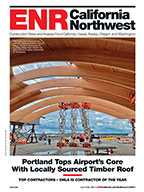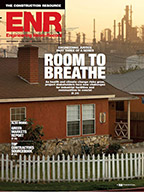Seismic joint hinges connecting the bridge pieces provide up to 8 in. of flexibility so the structure will remain intact in the event of an earthquake up to magnitude 8.0.
Because the ground is in danger of liquefaction in a seismic event, crews stabilized the soil using a deep-soil concrete mix. Drill rigs equipped with six jets injected 110,000 cu yd of cement and water in grid patters up to 60 ft below grade to create a thick slurry.
A pet cemetery located directly below the southbound high viaduct bridge was protected by a 105-ft-long concrete platform made of prestressed concreted girders, according to David Pang, Caltrans construction manager for Phase 1.
Construction of the southbound, 850-ft, five-lane Battery Tunnel was included as part of Phase 1. Challenges locating and moving utilities pushed tunnel excavation into the wettest stretch of a rainy 2010 winter, according to Pang. Lead contractor R&L Brosamer, now part of the Walsh Group, used a shoring system of struts and tiebacks that reached 20 ft under the cemetery to support a 40-ft-deep cut. “We were working within inches on both sides,” says Pang. The tiebacks cut the time required to remove 100,000 cu yd of material from one year to six months.
Brosamer crews used a traveler system to cast in place 65-ft-long sections of the walls and roof to build the cut-and-cover tunnels in an arched portal design. The first tunnel carried traffic in both directions until contractors built its northbound twin during Phase 2.
Brosamer crews also constructed a five-lane temporary bypass—using lightweight cellular concrete as fill material to reduce settling in the high water table area—during a road closure lasting just under 57 hours in April 2012. During this continuous work period, more than 40 demolition hammers dismantled the old 3,300-ft viaduct and “conflict points” where old and new roadways crossed. It was the largest roadway demolition completed over a single weekend in California history, says Molly Graham, Presidio Parkway communications officer.
Opening of the alternative route made way for the start of Phase 2 in 2012. For the next three years, Transfield Services managed traffic on the five lanes of the bypass road using a movable median barrier with a zipper truck while the southbound tunnel carried traffic in both directions. Use of the temporary bypass allowed the vital roadway to remain open and saved an estimated year of construction time, says Peter van der Waart van Gulik, CEO of Golden Link Concessionaire. Breaking the project into two phases also allowed Caltrans to qualify for funding from the American Recovery and Reinvestment Act.
Under the P3, Flatiron/Kiewit built the northbound Presidio Viaduct and Battery Tunnel to mirror the Phase 1 work. Phase 2 also included construction of the Main Post Tunnels and the new Girard Road Interchange. At one point, 300 workers were on site in the space-restricted area with three shifts going seven days a week. “Staging was less of a problem because as soon as materials arrived they went up,” says Adam Mathews, design-build manager for Flatiron/Kiewit.
The four tunnels, which vary in length from 750 to 1,030 ft, will include advanced monitoring equipment, including carbon monoxide and heat detectors, a deluge water system, emergency lighting and 150-horsepower “hurricane-force” jet fans that can move air at a speed of 22 mph. “This is not your ordinary roadway,” says Mathews.
An operations and maintenance center constructed in a restored Presidio building includes voice evacuation and video incident detection systems.







Post a comment to this article
Report Abusive Comment